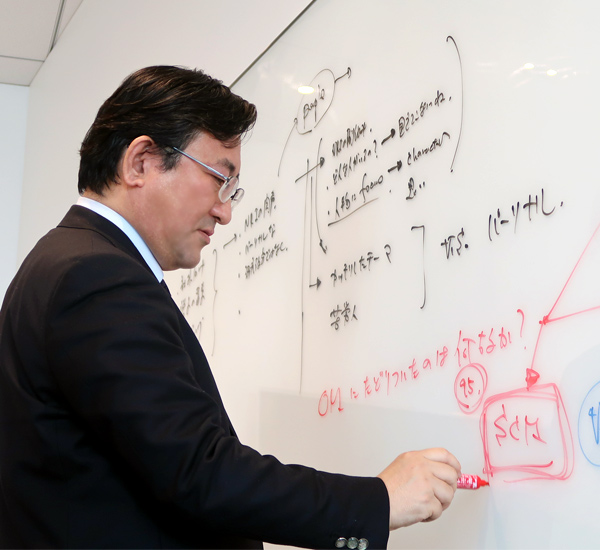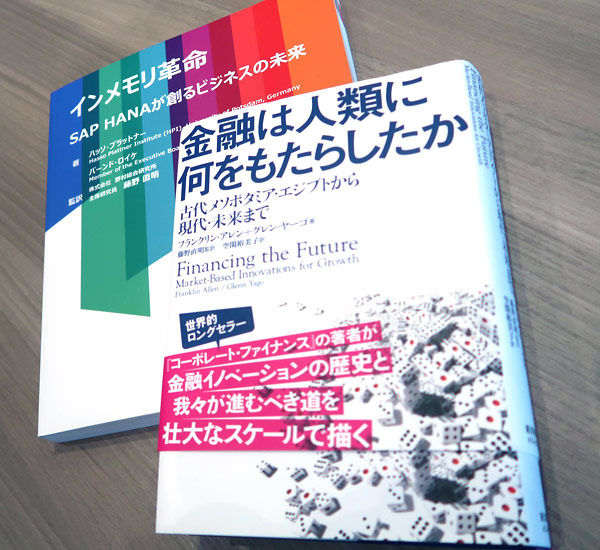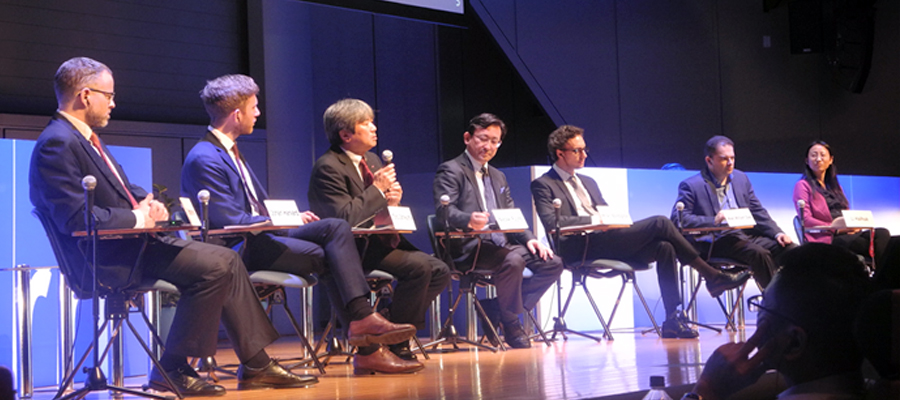
From a systems development standpoint, the person who led the way in Japan towards the successful implementation of Operations Management (OM)—which involves managing “super-upstream” processes like operations design and reformation—was NRI’s Naoaki Fujino. OM is an approach that involves designing your management framework as a “system” for integrating a wide variety of management resources and quickly adapting to environmental changes. Nowadays, standardization policies for hot topics such as the Fourth Industrial Revolution, omnichannel retailing, the “servicization” of the manufacturing industry, and open innovation all fall under the rubric of OM. While there are many researchers active in this field outside of Japan, it is not widely known in Japan. Yet our Mr. Fujino is tirelessly spreading the word about the fundamentals of OM, so that Japanese companies can boost their competitiveness on the global stage.
Learning the Necessity for Evidence-Based Studies and Research
I joined NRI in 1986. I’d studied theoretical physics in college, so I knew nothing about the social science fields, and my seniors at the company really helped me a lot. I think it was a good thing, though, that I was able to get involved in various activities without having any preconceptions. For my first 10 years at NRI, I was mainly engaged in think tank work (e.g. policy research) for government administration projects, for clients including the METI (Ministry of Economy, Trade and Industry), the MOF (Ministry of Finance), the MLIT (Ministry of Land, Infrastructure, Transport and Tourism), the MIC (Ministry of Internal Affairs and Communications), the MAFF (Ministry of Agriculture, Forestry and Fisheries), and various local municipalities.
In 1990 I had the chance to study development plans for Costa Rica, and I have good memories of my face-to-face discussions with the Vice President and ministers from various agencies in Costa Rica, as well as with the World Bank, the IFC, and the OAS in Washington, DC.
At the time, I was responsible for what we now call analytics (quantitative analysis), developing and running simulations with quantitative models, and doing all sorts of planning based on future projections. I worked on population projections, economic and fiscal frameworks, industry structure predictions, and supply and demand structures for transportation and distribution. I also handled lots of projects that entailed building quantitative models based on analyses of huge amounts of data owned by government offices, running simulations for future administrative structures, and designing various kinds of social infrastructure.
There were two things that I gained from doing these projects. The first was that I got hands-on experience with the fascinating world of simulations and algorithms. Being able to discover stable structures even in radically changing environments was extremely interesting for someone like myself who came from a natural sciences background. And now we’re in an AI boom, but actually, in many respects optimization algorithms are better. I feel that it’s a bit careless to think that AI algorithms can just be applied to any problem.
Those projects also really drove home for me how intense but also how enjoyable policy research can be. My experiences in those times have greatly contributed to the policy proposal discussions I have these days with ministry officials in the Kasumigaseki area of Tokyo, on topics like the Fourth Industrial Revolution and Society 5.0. Lately, people are re-acknowledging the importance of EBPD (Evidence-Based Policy Decisions), but on a government level, the difficulties of interpreting data and the strictness of the logic involved in decision-making, which carries serious responsibilities, were of a totally different dimension.
Actually, my experience with simulation models for large-scale transportation and distribution projects around that time also helped when I was subsequently developing SCM algorithms for corporate clients. You might say that my eventual recognition as a fellow by a professional algorithm group and the Operations Research Society of Japan was the result of the work I did at that time.
The World of Global EDI Standards on the Eve of the Internet Revolution
In 1989, I had an opportunity to study the EDI (Electronic Data Interchange) standards, which would later serve as a major theoretical pillar for information system designs in industrial areas. EDI is a framework for B2B electronic information exchanges using a globally standardized format. This was a strategic and ambitious project for its time, with the goal of constructing a global network through partnerships with members in the global distribution industry. I made a solo visit to DG13 of the European Commission, where I learned the details of the events leading up to the establishment of UN-EDIFACT, which would later be a valuable asset. That was the first time I clearly perceived the concept of a global ecosystem. And this experience would contribute significantly to my understanding of the Fourth Industrial Revolution going on these days.

Around the mid-1990s, EDI went through another round of rapid development in the form of internet-based EDI. This is when ERP (enterprise resource planning) systems predicated on the use of EDI first came on the scene, and it marked the beginning of the digitalization of corporate activities. It’s also when the SCM concept first truly crystallized in the West, and when NRI—albeit on a smaller scale—formed its first SCM oncept first truly crystallized in the West, and when NRI—albeit on a smaller scale—formed its first SCM team as a mixed force of consultants and system engineers.
Toward an Era Where Companies Are Connected Over Massive Networks
Since the mid-1990s I’ve slowly been shifting toward doing consultations for private companies, mainly in the SCM field. I think it’s because the rise of the internet has caused the global use of SCM to expand rapidly. At this time, I began getting involved in launching new businesses with a mixed team made up of members from our systems and consulting departments. Currently, I’m working on the ERP cloud service project that’s being carried out in Asia. I travel to Hong Kong and Singapore about twice a month, giving local seminars and visiting companies there. I can’t tell you how delighted I am to be growing the largest ERP cloud service offered by any Japanese company, which is now being used by 120 client sites in Asia.
I penned an article titled “The Essence of Supply Chain Management and its Impact on Corporate Management”, because I wanted to address the topic of SCM in the Fall 1998 Special Edition of the “Harvard Business Review (Japanese)”, which was issued quarterly at the time. I later published a book based on that article, called “Introduction to Supply Chain Management” (Nikkei Inc.). A Chinese-language version of the book was released in 2017, and it’s become a long-selling publication that’s still being reprinted.
The Importance of Operations Management (OM), and the Fourth Industrial Revolution
Put simply, OM refers to the engineering of operations designs for enabling organizations to continuously exploit their maximum potential. SCM is a representative example of this. Generally speaking, in many cases it’s still believed that if ground-level workers in sales, manufacturing, and distribution departments independently set their own KPI and work to reach their own goals the overall company will do well. Yet in times of remarkable environmental change, the more that individual workplace units work in a piecemeal fashion, the worse the company will do as a whole. This is what’s known as the divergence between aggregating partial optimizations and achieving full-scale optimization. The way to avoid this sort of pitfall and design a dynamic total optimization is by using OM. In fact, IOT and the Fourth Industrial Revolution are key topics in the area of OM.
SCM and recent hot topics like the Fourth Industrial Revolution, IIOT (Industrial Internet of Things), digitalization, digital transformation, and servicization are all research subjects in the OM field. From the perspective of someone who specializes in OM, it’s unfortunate but it has to be said that the essence of OM is not grasped by many companies in Japan today. OM is a relatively easy concept to understand, but in the first place, business schools at Japanese colleges and graduate schools do not have well-rounded programs. OM is, so to speak, an “integrated field” that combines the social science of business administration with the scientific field of industrial engineering, so it’s a difficult topic to situate academically. I’ve been told by people at universities that there are no professors that teach it, which is a big problem.
The Essence of the Fourth Industrial Revolution, A Topic Not Easily Understood in Japan
The aim of the Fourth Industrial Revolution is to create frameworks for transforming tacit knowledge, namely managerial and manufacturing knowhow, into explicit, organizational knowledge in a digitalized form, making it possible to scale out your business. In other words, its purpose is to construct business systems in a digital space. The Fourth Industrial Revolution has been discussed in the media in terms of unit cost reductions, something achieved by putting sensors on your equipment to collect data and having AI analyze that data, so management persons will often ask me why something like that would be called an industrial revolution. One of the essential features of the Fourth Industrial Revolution is creating a manufacturing framework supported by a global “mother factory” that can be
The Japanese education system is so good at playing a sort of catch-up and intensively training new experts that maybe at some point it forgot about the idea of synthesis. I think we’re lacking when it comes to a synthesized systems-based approach—that is, a system of systems (SoS) approach that involves planning out the connections among multiple systems from a global standpoint. When NRI was founded, it advocated for a systems approach that integrated the arts and sciences. My feeling is that the role NRI must play is becoming more and more important.
A Chance for Japanese Companies to Expand into Global Markets

IOT and the Fourth Industrial Revolution present an opportunity for Japanese enterprises—including SMEs—to participate in the global ecosystem and grow as global companies. The growth of Japanese enterprises leveraging the global ecosystem would likely revitalize Japan, and an effective way to accomplish this would be to cultivate exceptional consulting personnel who can disclose the results of OM research to top executives and manage the reformation work. I’m glad to say that NRI has corporate clients which now possess outstanding OM capabilities in the financial, major merchandising, and distribution industries, and these companies have deployed our OM framework around the world. I hope to leverage the experience I’ve gained at NRI to help solve the challenges faced by the corporate and industrial world these days, together with NRI’s talented personnel and using the most advanced OM practices.

Mr. Fujino acting as the moderator at the International Symposium of the Robot Revolution Initiative (RRI) (International Robot Exhibition at Tokyo Big Sight held on November 30, 2017)
Profile
-
Naoaki FujinoPortraits of Naoaki Fujino
Human Resources Planning & Knowledge Development Department, Industrial Solution Business Development Division
Consulting Division, Systems Consulting Division, International Business DivisionMr. Fujino joined Nomura Research Institute in 1986. His work involves policy research for the Japanese government and local municipalities, as well as operational reforms for Japanese corporations. He is a fellow at the Operations Research Society of Japan, Director of the Japanese Operations Management and Strategy Association, Leader of the Intelligence and Marketing Team for the RRI, and a visiting professor at Waseda University’s Graduate School programs, and he also gives undergraduate- and graduate-level lectures. His publications include “Introduction to Supply Chain Management” (Nikkei Inc.; also published in Chinese) and “Supply Chain Management: Theories and Strategies” (Diamond Harvard Business Review Anthology).
* Organization names and job titles may differ from the current version.